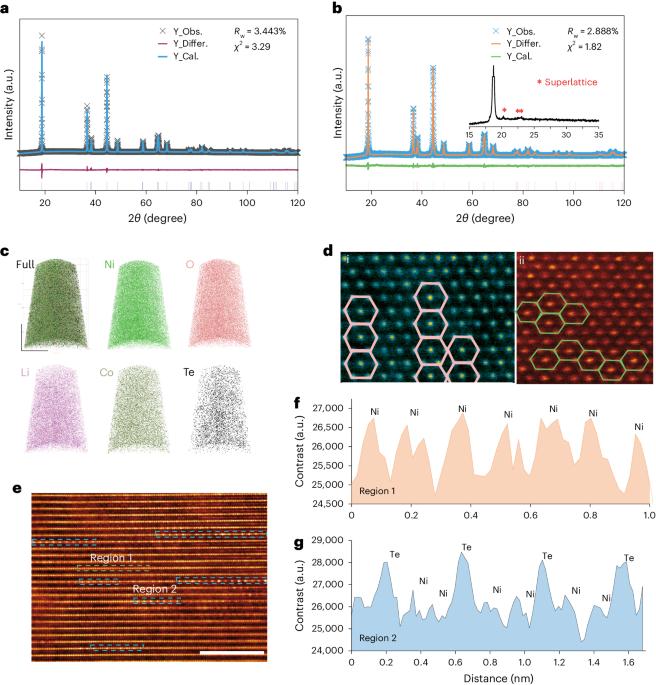具有循环稳定性的超高镍层状正极可用于可持续锂离子电池
IF 25.7
1区 环境科学与生态学
Q1 ENVIRONMENTAL SCIENCES
引用次数: 0
摘要
与钴制剂相比,富镍层状过渡金属氧化物具有容量大、成本低和环境可持续性强等优点,是锂离子电池的主要阴极候选材料。然而,镍的富集伴随着循环过程中更大的体积变化以及氧气稳定性的降低,这都会导致性能下降。在这里,我们展示了一种超高镍阴极 LiNi0.94Co0.05Te0.01O2,它通过引入高价碲阳离子(Te6+)解决了所有这些关键问题。这种制备好的材料显示出每克高达 239 毫安时(mAh)的初始容量和 200 次循环后 94.5% 的惊人容量保持率。由此产生的带有硅碳负极的 Ah 级锂金属电池的单体能量密度高达每公斤 404 瓦时 (Wh),循环 300 次后容量保持率为 91.2%。先进的表征和理论计算表明,碲的引入有助于设计微结构的颗粒形态,以更好地适应晶格应变,并实现层内 Te-Ni-Ni-Te 有序超结构,从而有效调整配体能级结构并抑制晶格氧损耗。这项研究不仅将镍基锂离子电池的能量密度提高到了 400 Wh kg-1 的水平,而且为正极材料的结构设计带来了新的机遇,使其在性能和可持续性之间不存在权衡。增加镍含量以取代钴可以提高电池正极的容量和可持续性,但会导致性能下降问题。在此,作者通过掺杂碲来解决富镍阴极的结构和氧不稳定性问题。本文章由计算机程序翻译,如有差异,请以英文原文为准。

Ultrahigh-nickel layered cathode with cycling stability for sustainable lithium-ion batteries
Nickel-rich layered transition metal oxides are leading cathode candidates for lithium-ion batteries due to their increased capacity, low cost and enhanced environmental sustainability compared to cobalt formulations. However, the nickel enrichment comes with larger volume change during cycling as well as reduced oxygen stability, which can both incur performance degradation. Here we show an ultrahigh-nickel cathode, LiNi0.94Co0.05Te0.01O2, that addresses all of these critical issues by introducing high valent tellurium cations (Te6+). The as-prepared material exhibits an initial capacity of up to 239 milliampere-hours (mAh) per gram and an impressive capacity retention of 94.5% after 200 cycles. The resulting Ah-level lithium metal battery with silicon-carbon anode achieves an extraordinary monomer energy density of 404 watt-hours (Wh) per kilogram with retention of 91.2% after 300 cycles. Advanced characterizations and theoretical calculations show that the introduction of tellurium serves to engineer the particle morphology for a microstructure to better accommodate the lattice strain and enable an intralayer Te–Ni–Ni–Te ordered superstructure, which effectively tunes the ligand energy-level structure and suppresses lattice oxygen loss. This work not only advances the energy density of nickel-based lithium-ion batteries into the realm of 400 Wh kg−1 but suggests new opportunities in structure design for cathode materials without trade-off between performance and sustainability. Increasing the Ni content to replace Co can increase the capacity and sustainability of cathode for batteries but leads to performance degradation issues. Here the authors address the structural and oxygen instabilities of Ni-rich cathodes by doping with tellurium.
求助全文
通过发布文献求助,成功后即可免费获取论文全文。
去求助
来源期刊

Nature Sustainability
Energy-Renewable Energy, Sustainability and the Environment
CiteScore
41.90
自引率
1.10%
发文量
159
期刊介绍:
Nature Sustainability aims to facilitate cross-disciplinary dialogues and bring together research fields that contribute to understanding how we organize our lives in a finite world and the impacts of our actions.
Nature Sustainability will not only publish fundamental research but also significant investigations into policies and solutions for ensuring human well-being now and in the future.Its ultimate goal is to address the greatest challenges of our time.
 求助内容:
求助内容: 应助结果提醒方式:
应助结果提醒方式:


